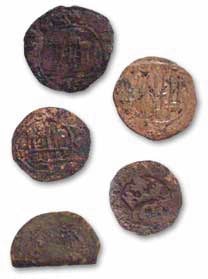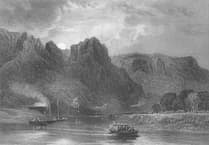THE timbers of a magnificent 15th century sailing ship built of Forest of Dean oak are being won piece by piece from a muddy grave after she suffered an unknown accident at sea.
Recovering the ship, a merchantman which may also have served military purposes, is as exciting as the raising of Henry VIII's flagship Mary Rose, says John Inglis, the Newport archaeologist spearheading the project.
Once the timbers are stabilised they are being moved to a specially dug basement constructed under Newport's art gallery for a permanent display.
She was discovered in the mud of a 'pill' or creek in the tidal River Usk, within sight of Newport Castle, and has already yielded a treasure of coins and artifacts.
"From the dendrochronology its is fair to assume the oak timbers are from the Forest of Dean and she may well have been built in the area too," said Mr Inglis.
"We know little of shipbuilding at the time but the pills make ideal natural harbours and dry docks for construction and repairs."
The last piece of the jigsaw, the keel, revealed a surprise – it was made of beech, an Iberian tradition associated with shipbuilding in Spain and Portugal, and may well have been a replacement.
In fact she shows signs of several repairs in the 50 odd years she was sailed, probably between the Severn and Portugal. It is believed she suffered some accident at sea and was bought here and beached in the creek for repairs.
"We don't know why she was abandoned and, sadly, we will probably never know her name," said Mr Inglis.
The visible remains of the ship extend to 21 metres and it is thought that its original length was around 25 metres. Tree-ring dating has shown that the green oak timbers used for its construction were felled between Autumn 1465 and Spring 1466. The ship is clinker built.
Archaeologists have found over 300 objects in the mud that filled the Newport ship. The finds include Portuguese pottery, leather offcuts and leather shoes, rope, pulley blocks and other ship's rigging, cork from Portugal, coins, sail cloth and stone shot.
Two of the most exciting finds are pieces of brass strip inscribed with medieval Latin text.
It is thought that these beautifully detailed pieces could have come from a casket for holding precious objects. The script, which reads "medium illoru[m]" and means "through the midst of them", probably comes from Luke chapter IV verse 30 and was a popular charm of the period used by travellers to ensure a safe passage.
Archaeologists have nearly finished the lengthy process of lifting the ship. Because it is embedded in the Usk mud it is not possible to lift it in one piece like the Mary Rose. Instead the team of archaeologists have dismantled the ship timber by timber and deconstructed it within the ground so that the first timbers laid down over 500 years ago by mediaeval shipbuilders will be the last to be lifted.
Once lifted the timbers are sprayed with water – they quickly start to deteriorate when exposed to the air – and transported to wet storage where they will be cleaned further and recorded in detail.




